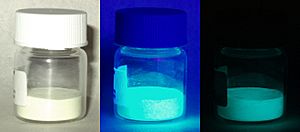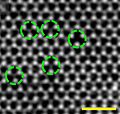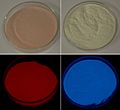Phosphorescence facts for kids
Phosphorescence is a cool way some materials glow in the dark. It happens when a substance soaks up energy, usually from light, and then slowly lets that energy out as light. Think of it like a sponge soaking up water, but instead of water, it's light energy!
This is how many "glow-in-the-dark" toys and objects work. You "charge" them by holding them under a bright light. Unlike a fluorescent light that glows instantly and then stops, phosphorescent materials hold onto that energy for a much longer time. They release the light slowly, making them glow for minutes or even hours after the main light source is gone.
Contents
How Does Phosphorescence Work?
When light hits a phosphorescent material, tiny particles inside called electrons get excited. They jump to a higher energy level. In most materials, these electrons quickly fall back down, releasing light right away. This is called fluorescence.
But in phosphorescent materials, there's a special "trap" for these excited electrons. They get stuck in a slightly different energy state. It takes a bit longer for them to escape this trap and fall back to their normal energy level. When they finally do, they release the stored energy as a photon of light, which is what we see as a glow!
Storing Light Energy
Imagine a ball rolling up a hill. If it rolls straight back down, that's like fluorescence. But if there's a little dip or shelf on the way down where the ball can rest for a while before continuing its roll, that's like phosphorescence. The "dip" is where the electrons get temporarily trapped.
The time it takes for the electrons to escape these traps can vary a lot. Some materials glow for only a few seconds, while others can glow for many hours. This is why glow-in-the-dark stars on your ceiling can keep glowing long after you turn off the lights at bedtime.
Where Do We See Phosphorescence?
You might not realize it, but phosphorescence is all around us! It's used in many everyday items.
Glow-in-the-Dark Toys
The most common place to see phosphorescence is in toys. Things like glow sticks (though these use a chemical reaction, not true phosphorescence), glow-in-the-dark stickers, and action figures often use phosphorescent materials. They are fun because they can be "recharged" again and again just by exposing them to light.
Safety Signs and Watches
Phosphorescence is also very important for safety. Many emergency exit signs in buildings glow in the dark so you can see them even if the power goes out. The numbers and hands on some watches also use phosphorescent paint. This lets you tell the time in the dark without needing a backlight.
Cool Art and Science
Artists sometimes use phosphorescent paints to create amazing glowing murals or designs that change when the lights go out. Scientists also study phosphorescence to understand how different materials store and release energy. This helps them create new and better glowing materials for all sorts of uses.
Images for kids
See also
 In Spanish: Fosforescencia para niños
In Spanish: Fosforescencia para niños










